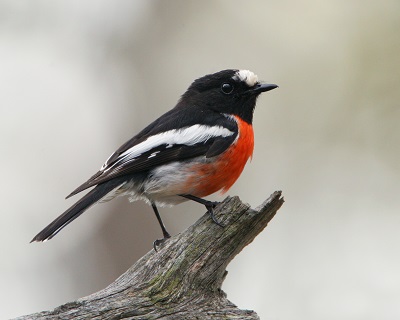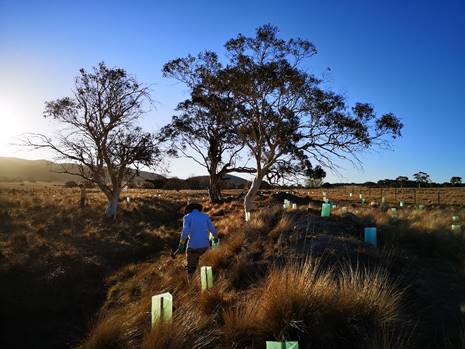Help save our scarlet robin - why are they declining when others are not?
September 2020
Andy Taylor, Senior Land Services officer, Palerang and Damon Oliver, Threatened Species officer, NSW DPIE.
Back in June we received a lot of interest in an article about the plight of the scarlet robin and other woodland birds following the extended drought and bushfires across the south east of NSW. This article provides a more detailed insight into the group of threatened woodland bird species that many of us are trying to help as part of the Save Our Scarlet Robin Program and why we see certain birds more than others.
A lot of common native birds that we see in urban and rural landscapes, including our farms, have benefited from human activities like agriculture and urban development. These are often the large, noisy and aggressive native birds like ravens (crows), magpies, sulphur-crested cockatoos, little corellas and noisy miners. They have become overabundant in many regional and urban areas as they thrive in landscapes where natural habitat has been simplified to create open paddocks and grasslands and increased available standing water and foods such as crops and livestock feed. Because of their adaptability, they have outcompeted many of the smaller bird species that require specific and more complex habitats for breeding and survival.
Unfortunately, there is now a long list of small bird species that are listed as threatened or declining and they urgently need our help.
Most of the birds in trouble breed and feed in the lower shrub and ground layer. One of the bird groups in decline are those we call insectivores. They feed on insects and other small invertebrates that they prey on in the shrub and ground cover, often amongst leaf litter or fallen timber. These include the wrens, robins, thornbills, treecreepers, warblers and thrushes. Another suite of species in trouble are the granivores that feed on seeds that they take from native shrubs and ground cover plants. These are the finches, parrots, pigeons and doves.
So why have studies on woodland birds found that the smaller insect and seed eaters are the most vulnerable to extinction?
There are two key reasons. Firstly, the loss and simplifying of natural habitats from frequent fire, too much grazing by native and introduced grazing animals, and removal of fallen timber by humans has reduced the amount of habitat for these birds. Humans have a natural tendency to want things to be neat and tidy but nature and our small woodland birds like things messy and complex to provide shelter and food sources. The general loss of habitat and shelter has exacerbated the second key threat to many small birds and that’s predation by feral cats and foxes. Without enough trees, shrubs and ground cover protection, our small birds find it hard to feed, breed and move from place to place without getting eaten by predators. Local Land Services can assist land managers with feral animal control through training and the supply of traps and poison baits.
The Scarlet Robin Program
The Save Our Scarlet Robin project aims to help farmers and other land managers to protect and restore critical habitat for small birds. Coincidentally, these activities can have a positive effect on farm productivity by stabilising soils, reducing impacts from storms and providing shade and shelter for livestock. Some of our most beautiful and best-loved small woodland birds like the scarlet robin, flame robin, diamond firetail, hooded robin, brown treecreeper, speckled warbler and dusky woodswallow are the focus of this project. Read more about them and other woodland birds here.
Keep an eye out for more articles about woodland birds and our environment in future editions of the South East Circular.
And as always contact me if you’d like more information on anything in this article.
Andy Taylor
Senior Natural Resource Management Advisor
South East Local Land Services
0427 750 891
andy.taylor@lls.nsw.gov.au

